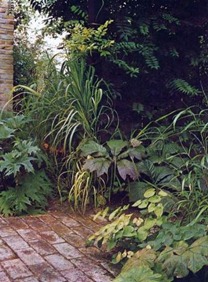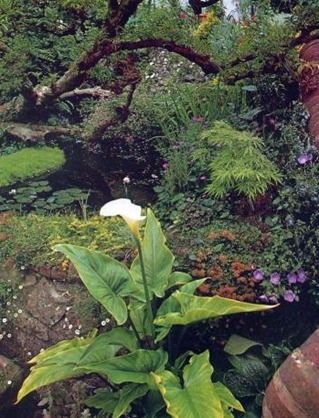





A shady garden is not the ultimate disaster that many people think it to be. Indeed the phrase may describe anything between a small town patch which literally gets only a gleam of sun in the height of summer and one in which quite a lot of sun is obtained, but where it comes at the wrong time and in the wrong place. A first clear statement should be made: this is that the most completely sunless spot can be enlivened and beautified by plants, for there are many species whose whole evolutionary development has led them to colonise successfully such an ecological niche. In the wild this is likely to be on the floor of thick forest (indeed the reason why so many well-known house plants succeed in dark rooms is that they are from equally dark jungles) or at the bottom of rocky gorges. But if their other needs are met — of moisture, nutrients and an acceptable temperature — they will not recognise a dark city area as anything different.
 Because of the usually small space involved this situation is not a problem. Walls should be whitened to reflect as much light as possible and an emphasis put upon plants whose effect is similar. Evergreens should be chosen with glossy, highly reflective leaves. Camellias hollies, aucubas and many others have this attribute, whereas yews and other conifers with duller foliage should be avoided.
Because of the usually small space involved this situation is not a problem. Walls should be whitened to reflect as much light as possible and an emphasis put upon plants whose effect is similar. Evergreens should be chosen with glossy, highly reflective leaves. Camellias hollies, aucubas and many others have this attribute, whereas yews and other conifers with duller foliage should be avoided.
Similarly, variegated leaves have a lightening effect: Elaeagnus pungens, Fatsia japonica, hollies again and Euonymus fortunei while excellent and shade tolerant in their normal green manifestations also have forms whose leaves are striped with gold or edged with white. For small gardens such variegated plants are particularly useful as the reduction of green photosynthetic leaf area, which variegation naturally entails, does reduce vigour. Watch must be kept for all-green ‘reverting’ shoots which should be removed at source.
All the shrubs so far mentioned are possible tub or raised-bed plants. Camellias lauded in several sections of this website are especially useful in the latter situations. So long as acid soil is available and adequate water given throughout the year, a dark courtyard can be set aflame for three months in spring with their exotic flowers.
There are less good seasonal plants for dark spots than one would wish. A spring display is not difficult if the emphasis is put upon bulbs and polyanthus and if it is fully realised that they will need annual replacement. Planted in October or November, narcissus, hyacinths and tulips all have their flowers fully formed inside the bulb. The spring will bring them out and a splendid array can be obtained through careful choice of varieties from February to early June. Go to specialist catalogues for these as the local shop seldom carries a large enough range. But sun and warmth is necessary if they are to build up flower buds for the following year and this is why it is seldom worth leaving them in in really shady spots. Crocuses, by the way, are no use here because they only give of their full beauty by opening in full sun.
Summer annuals are apt to become very leggy in shade and produce leaf at the expense of flower. Therefore avoid choosing plants known to thrive in sun such as pelargoniums (geraniums so called), gazanias and most other ‘daisies’. Good are the new impatiens hybrids (Busy Lizzie) and even petunias can thrive.
 Problems of the bigger garden with excess shade are both simpler and, in some cases, worse. Situations of deep tree shade, with the tree roots having just as wide if not a greater spread as has its leafy top, are areas of dry shade as well. Irrigation obviously helps but the tree is going to benefit the most.
Problems of the bigger garden with excess shade are both simpler and, in some cases, worse. Situations of deep tree shade, with the tree roots having just as wide if not a greater spread as has its leafy top, are areas of dry shade as well. Irrigation obviously helps but the tree is going to benefit the most.
Where, however, space permits a certain amount of flexibility the basic design of the garden must be geared to the availability of sun. Orientation of paths and vistas may not be able to follow the obvious lines from doors and windows because those ways may not lead to the sun. If the sunniest spot is where the dustbins normally live then they must be made to realise that they are occupying a space far beyond their situation in life.
Similarly, while it is highly desirable to have the terrace leading straight from the house, there is no point in slavishly following convention if it only gets sun for an hour in early morning. In any road running east to west there are going to be just as many north-facing backs as the more desirable south and so basic a fact has to be accepted.
All is not gloom; there are real advantages. Interesting shade-loving plants can be brought right up to the house — hellebores and bergenia for winter and early-spring interest; primulas and lily of the valley can follow while the summer is a mass of cranesbill (geraniums — true ones) hostas and a host of others which a plantsman in a hot garden would give his eye-teeth for.
Another great advantage of a north-facing house aspect is that, because plants in flower always look towards the sun, it follows that once beyond the immediate shade of the house flowers will be facing south and hence the viewer from the windows. This is a considerable pleasure. Beyond this, in a garden where both deep shade and sun exist, dramatic effects can be contrived where plants can be high-lighted by the sun yet seen against the darker background.
While, therefore, a juxtaposition of shade and sun enlivens a garden and is highly desirable, where shade is preponderant it is not wise to just go ahead as if full sun was a gardening birth-right. It has already been indicated that there are numbers of splendid evergreen shrubs which will take full shade, very many others will enjoy partial shade and often their flowering time is lengthened by it. But certain groups of plants or coveted garden features are best avoided.
As regards groups of plants, the great majority of Mediterranean shrubs and shrublets become atypical, even if they grow at all, in the shade. Many of these are the invaluable scented herbs — rosemary, sages, lavenders, savory — and their flowering associates — cistus and santolinas. Sadly in shade flowering is reduced, growth becomes lax and much of their piquant fragrance is lost. Much better is to accept defeat here and concentrate on things which will do well. The cool greenness of a shady place is enhanced by nonflowering plants and many ferns, notably Dryopteris felix-mas, Polypodium vulgare and Polystichum setiferum will take dry shade with impunity so long as the soil has a reasonable amount of humus. With a little natural moisture the range of lovely ferns increases dramatically and they associate beautifully with meconopsis (Himalayan poppies), candelabra primulas and a host of lovely goodies.
Other areas of specialist interest which the shady gardener (no disrespect intended) will have to avoid are rock gardens and pools, at least in the conventional sense. Alpine plants are evolutionally adapted to extremely high-light levels, just as the Mediterranean herbs are in their different environment. They must, therefore, be exchanged for small plants which are basically woodlanders. Many of these insist upon an acid soil and hence are admirable for a peat garden. Here limestone rocks must be avoided and porous sandstone used for supporting walls. In moist conditions peat blocks are admirable through which a range of exciting little plants can grow. However, they shrink and curl if allowed to dry out.
A trickling rill winding through this sort of woodland is both aesthetically and cultivationally desirable. But open water in shade is seldom anything but redolent of gloom, and if the water is tree shaded, decaying leaves build up a broth which is inimical to fish and aquatic plants alike. Surprisingly a tiny trickle fountain in a dark courtyard is not so. It usually develops a surrounding growth of algae and mosses of a brilliant veridian green encouraged by its tiny moist microclimate. Any other way in which the minutiae of a shaded area can be ameliorated will help towards its potential as a place for growing plants.
Copyright © www.100flowers.win Botanic Garden All Rights Reserved